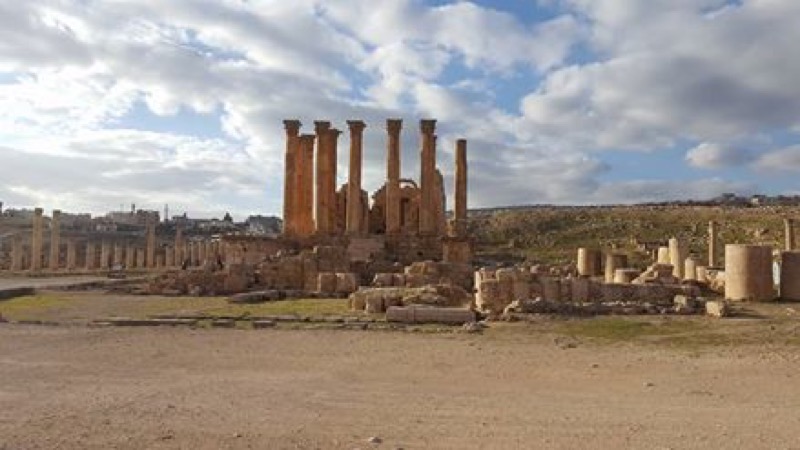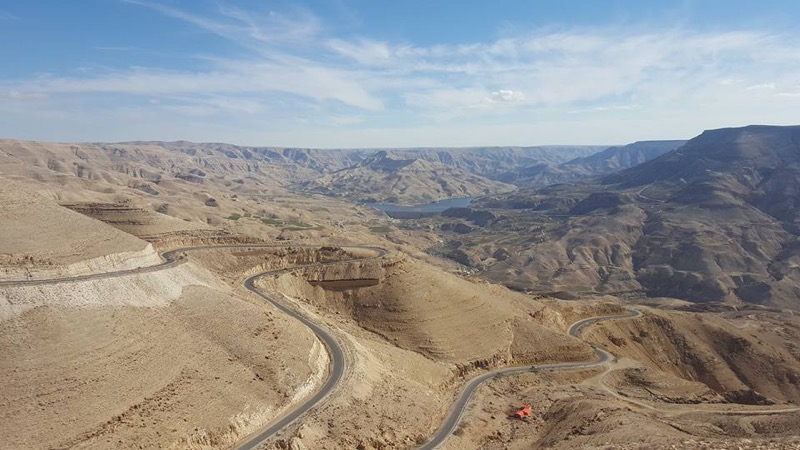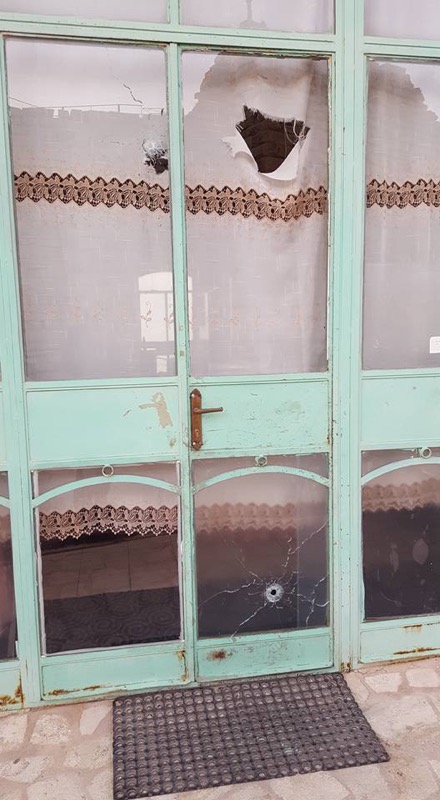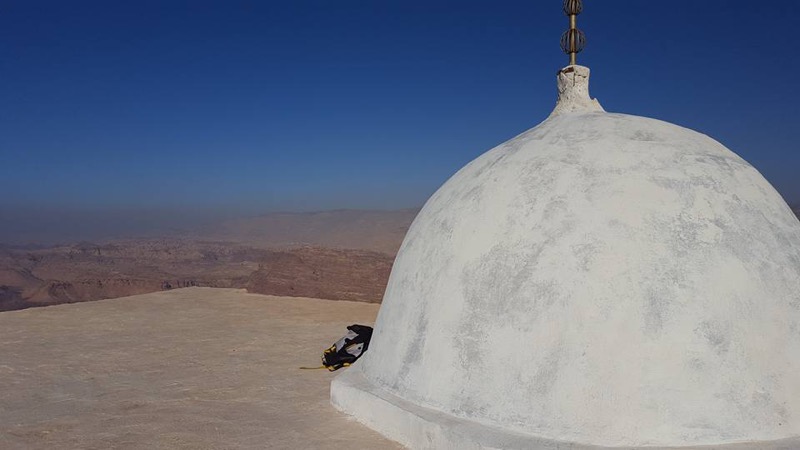Jordan
Blog post from the ten day trip I did from the North to the south of Jordan in the winter of 2016.
I grew up in the North of England, which was, at one point, the barbarous northern edge of the Roman empire. A mere five hour flight away is the Jordanian capital of Amman and the nearby Roman ruins of Jerash. Strange to think then that, around 2000 years ago, one could have made this trip overland without ever leaving the empire in which you started. Depending upon your route this trip might now take you through 11 different countries. Somewhat short on time, and not fancying a run in with Assad’s thugs or ISIS, I opted for the 5 hour BA flight from Heathrow to Amman Queen Alia airport. North of the city of Amman is the Roman ruin of Jerash. Hadrian’s wall this is not, this place is a massive labyrinth of grand imposing spaces and towering pillars, testament to the genius of these great latin engineers. Another hour's drive north from here and you would be at the edge of another collapsing civilization: Syria. The only reminder of the tragic events taking place in Jordan’s fractious neighbour is the constant stream of Syrians that you meet on your travels, intensifying as you go further north towards the border. By contrast Jordan seems serenely calm, almost sleepily peaceful. But for the occasional other tourist and the overly zealous taxi drivers one is left to meander this great kingdom entirely at one’s own pace, and largely by oneself. Gone are the great hoards of tourists that once came here. Just as the Roman pillars tell of a people who once inhabited this land, the myriad empty tourist hotels tell of the tourists who similarly once descended on Jordan, but have since left the place.

One of the first things I noticed about Jordan, ancient ruins notwithstanding, is that the whole place looks incredibly new, certainly by the standards of other arab nations that I have visited. There are none of the medieval souks of Marrakech in Amman, instead the whole place is a rather drab looking 1970 concrete affair. To call Amman pretty would be a stretch; there is however a lot to occupy the discerning tourist. More grand Roman ruins, pretty Mosques, and the museum of Islamic culture. This is all very well, but after my long flight my first stop was the hammam (aka turkish baths). The place was typical of Jordan's decaying opulence. Completely empty as ever, and absurdly luxurious, given the small trickle of visitors that this place caters too. The whole place had a surreal edge to it, like the house of a mad old aristocrat who has frittered away his wealth and lives with his last remaining servant. Inside creaking pipes splutter out steam and occasionally spit droplets of scalding hot water onto your back, as if to taunt you. A flunky, with a knowing smile, served us hot mint tea before subjecting our bodies to an intense form of physical torture. Scrubbing us vigorously, determined to purge us of our skin (dead or otherwise), and then bending and clicking our bodies into shape with a flagrant disregard for the limits of the human skeleton. I came out slightly battered, but mentally and physically refreshed. I could get used to this. I considered staying in Amman longer, and living the life of a pampered colonial here in Amman’s Turkish baths and falafel houses, but there was so much more to see.
Jordan's native population is 95% Sunni Muslims, with the most of the rest being Christian; many of whom live in the town and surrounding areas of Madaba, a short drive South of Amman, which was the next stop on my Jordanian adventure. The main draw of the town itself is a mosaic of the holy land in the church of St George. Built in the 6th century by the Byzantines it offered the tourists of the time a stylistic representation of the highlights of the region. I was struck by how little the lonely planet I carrying around with me differs in its recommendations despite being authored a approximate 1400 years later. The map shows the dead sea and the surrounding highlights: Jerusalem, Jericho, Bethlehem all now in the Israeli occupied West-Bank. Confusingly the map is built east facing, so to the right, actually the south, is the town of Kerak, now famous for its crusader castle and the sight of a recent terrorist attack. Finally, and this is where the geographical realism of the map is more obviously lacking, it shows the Nile delta as it meets the mediterranean in Egypt. I feel a link with the past here as countless other tourists, stretching back to zenith of the Byzantine empire must have consulted this map as they made their own trip across what we now call the middle east.
Impressive as it is, the map in the church of st George is not enough to occupy a whole day, so in the afternoon I took one of the sight seeing tours around the surrounding areas. The first stop was mount Nebo, where, legend has it, God offered Moses his first sight of the promised land. The mountaineers among you will be sorely disappointed however, as this "Mountain" is a pitiful 900 m high, and it is possible to drive a car all the way to the top, where there is a gift shop and cafe selling Arabian tea and selling religious trinkets. One can't help but think that the Jordanian tourist board is slightly too keen to link locations with places mentioned in the bibel. Who can blame them really. In anycase the view is well worth the trip. It is from here that I got my first view into Israel. On a clear day it is said that it is possible to see all the way to Jerusalem from here, however, there it was a slightly hazy overcast day, so I could only see as far as the west bank town of Jericho. I have hazy recollections of Sunday school stories in which this town's walls were brought to the ground by a army of trumpeting Jews. I had never really thought of these towns as real places, but there it was sitting on the hill side in front of me. Further to the north there were endless agricultural fields growing olives and dates, not too changed, I imagine, from biblical times. As I left I couldn't help but wonder to myself if God new the political shit storm he unleashed when he promised this land to the descendants of Moses. Oh well! onwards.
The next stop on the tour was the supposed site at which John the baptiste dunked the head of a young carpenter into the river Jordan and so started a cult which is still going strong to this day. As monumental as the birth of the world’s largest religion is, I found the modern ppolitics of the site the more interesting aspect of the site. Territory to the West of the river Jordan would once have belonged to the Kingdom of Jordan. After Jordan declared war on Israel, in support of Egypt, and subsequently lost, Israel claimed the territory of what is now known as the west bank. Despite many of the Israeli settlements being declared illegal by the UN, the Israelis still control the borders of the west bank. The river Jordan, and the site of Jesus' baptism therefore, forms part of the modern day border between Israel and Jordan. Until more recently it would not have been possible to visit one of Christianity’s most important sites as this was part of a de-militarised no-go zone between the countries. Jordanian-Israeli relations have since thawed a little, so it is now possible to visit the site as part of a tour group. It is also possible to visit the site from the Israeli side. As you approach the river Jordan, which is actually a fairly unimpressive muddy trickle, you are confronted with tourists who are doing the same from the other side as if looking into some parallel universe. The contrast between what the two countries have done with the place is quite striking. The Jordanian side is mostly a modest Wooden structure with a simple roof made of straw. The Israelis, by contrast, have built an enormous concrete structure on their side, complete with modern shower and changing complex. Judging by the voices of the tourists on the other side I hear mostly accents from the USA, many of them dunking themselves into the water to recreate that fateful moment in world history. If they were to wade two meters further into the water they would have crossed illegally into Jordan. On the Jordanian side the tourists I hear are mainly Russian. The spectacle of them in their white robes, and highly coiffed hair dos dunking their heads underwater and their friends take snaps of them on their phones is rather amusing. I think to myself that there must be some wise observation I could make about Arabs and Jews, and Russians and Americans facing each other across some arbitrary border in the middle east, but I decide that it is not worth pushing further.
There are three main roads that all go from the capital, Amman, to the second city, Aqaba, in the south. The aptly named dead sea road along the eastern border hugs the dead sea and later the Israeli border. On the west side the equally aptly named desert road is for those in a hurry, as a triple carriageway bulldozes its way through endless arid nothingness. For those with a little time on their hands the king’s highway goes through the mountainous middle of the country, snaking its way up and down wadi after wadi. This is the route that I took to my next destination: Kerak. To get there it was necessary to take 7 different buses, over a stretch of just slightly more than 100 km. This may sound logistically challenging, but turned out to be easy enough. One has to simply show up at the first bus station and state your desired destination, the bus driver sets off, and then ferries you onto the next bus, passing on the message on to the next driver. Without speaking a word of the language, if you allow yourself to be herded like a scared little sheep, you will, as if by magic, make it to you destination. The king’s highway has to be one of the most spectacular drives that I have ever undertaken. The little mini bus, complete with mini faux-chandelier, tilts and swerves its way along the roads serpentine bends. I was the only tourist on a bus full of local commuters, who were intent on keeping all the curtains of the bus tightly closed as they tried to nap, oblivious to their dramatic settings. I sat there pulling the curtains to one side with my hand pressed to the window in awe. The relatively fertile north slowly gives way to the more arid south, the road is surrounded either side alternative by rising or, more worryingly, falling cliffs made of Marian like orange sandstone. The zenith of the trip, both literally and metaphorically, is the halfway point to Kerak known as Wadi musa, Jordan's answer to the grand canyon. All the way along this road, to the right if one drives South, is the dead sea, and beyond that, just visible, is Israel. As we stop by the side of the road I get chatting to a bedouin man, who is mostly interested in selling me some of his souvenirs, but is friendly enough. I casually try to bring up the subject of Israel with a feigned naivety. He simply grunts, the look of disgust in his eyes says it all. The mere mention of the I word is enough to get any Jordanian into a frenzied rant, best stay well clear of the topic, I complement the shawls that he is selling but politely decline to buy one and hop back on the bus.

My next stop is Kerak, which I reach as the sun begins to dip beneath the orange sandstone on the horizon. This is surely the destination of a travel contrarian. Just 10 days ago, as I was planning this trip, a group of radicals declaring allegiance to ISIS opened fire on a group of tourists, killing locals and visitors alike. In normal times the main attraction of the town is the crusader castle built imposingly on the hilltop above the town. This is where the terrorists staged there last stand against the police and the Jordanian army. The castle was still closed as the police search the area for any booby traps or remaining evidence. It was still possible to walk up to the entrance of the castle and to the cafe. I even saw a smattering of bullet holes along the glass facade of the gift shop/cafe. If Jordan in general was lacking in tourists, this place was doubly bereft of visitors, it seems the site of the aftermath of violent Jihad didn't hold the same appeal to your average tourist as it did to me. Armed police were patrolling the streets in conspicuous numbers. This must be one of the safest places in Jordan right now, however, given that the only real attraction of the city, along with most of its restaurants, were closed, I decided that it was time to head on, further into the south of the city. I couldn't help but feel sorry for those poor Jordanians who had decided to make their livelihood in the tourist industry. The latest event, miniscule though it was by the comparisons of the blood shed of neighbouring Iraq and Syria, will surely not help their cause.

My next stop was the nature reserve of Dana, and a tiny Ottoman town of the same name. Dana is a tourist destination that does quite enjoy the same fame as the nearby Petra (of which more later) but it is one that is well worth the stop. I stayed in a converted ottoman building, now a nice rustic guest house. I was travelling in January, and at this relatively high altitude it was actually close to freezing. One suffers from a form of cognitive dissonance to be surrounded by almost desert like features, and in the middle of the day a blazing sun which scorches the eyes, and yet to feel such an incredible chill. I was going to explore the park by myself, but I met a couple of French girls who wanted to share the cost of a tour the next day, so I decided to join them. Our bedouin guide took us on a trail through the labyrinth of rock, like an enormous pile wet mud that has dried and cracked in the midday sun, we scampered through these otherworldly rock formations. Our guide didn't speak a word of English, and we unfortunately spoke no Arabic, but our fixer assured us that he was taking us on a light scramble through the rocks; it was nothing of the sort. The only honest description of what we were doing was rock climbing without ropes. Unperturbed, our aging guide scampered across the rocks in his felt slippers; at one point we had to slide down a steep rock face, and then stop our descent by wedging our left feet on the opposing wall, edging along with legs either side of a 10 m high drop, all great activities to build an appetite. For lunch our guide lit an open fire at the bottom of the valley and we ate a tasty lunch of lamb Kofte and fried onions. A nomad passed us with a herd of goats, pausing to give us a nod of the head and continue his conversation on his old style nokia phone. I wanted to stop and talk to him, who are you? where are you going? what do you know of the outside world? what are your thoughts and dreams? but of course I couldn't. That must be one of the most frustrating aspects of foreign travel. You must either spend years mastering a difficult tongue, or resign yourself to only speaking to that particular group of people who can speak yours.

My last stop was Petra, which really has to be done on any self respecting tour of Jordan. I hitched a lift with a traditionally dressed Jordanian man along the 40 min drive to the town of Wadi Musa. He spoke surprisingly good English, and we whiled away the minutes talking about Islam, crusaders, as we passed the ruins of another castle, terrorism and politics, he assured me that Jordan was safe and that everyone here had nothing but contempt for the radicals spreading through Syria and Iraq.
Wadi Musa is a sprawling concrete monstrosity built exclusively to house the tourist visiting the nearby site of Petra. This is one of the few places in Jordan in which you meet other tourists in any great number, it is also one of the few places in which one feels a little hassled, as one is constantly asked to ride on a camel, or to buy a souvenir. Nonetheless, nothing compared to, say, Morocco, and usually done in good humour. Petra is not so much a site, singular, as a disperse complex of many sites, separated by strenuous hikes from each other. Built by the Nabateans, a civilisations of traders known to the Romans, in the 4th century Petra was not so much constructed as revealed from the rock. Like Michelangelo, who on sculpting David, said that he simply carved away anything that was not David, the Nabataeans simply took from the rock anything that was not Petra. Each building is made simply by chiselling away the mountain until all that is left is the desired shape of the building. Some of the structures are obviously cut into the rock, whereas others look free standing, with a little imagination you can envisage the shape of the mountain that must have been chiselled away to make such a structure, a mind boggling feet for this mysterious group of people to achieve in the 4th century. Despite the throngs of tourists, at least by Jordan's standards, and the myriad young men trying to tempt you onto their camels or donkeys Petra retains a magical feeling to it. The entrance is through a spookily quiet and cool souk which finally opens up to the iconic Treasury made famous by Indiana Jones. After exploring the sites of Petra for a whole day, on the second day I decided to make my way to mount Haroun, an important site in all three Abrahamic religions. Haroun, or Aaron, was Moses' brother and this is allegedly his final resting places. The guide book told me that I should leave 6 hours to get up and down here, I checked my watch and reconed that I had about four before the sun set, so I set off at a march, resolving to turn around no later than 3pm even if I didn't make it to the top. Along the way there were more Nabatean ruins strewn carelessly along the path, far from being a tourist attraction these 1700 year old buildings actually had people living inside them. As I passed hoards of kids emerged from their caves, out of these buildings begging me for small change or food, or simply wanting to race me to the end of the village. One of their parents came out and, scolding the children, invited me in for tea. To my great shame I had to turn them down, as I had only another two hours to make it to the top of the mountain that still loomed high above me in the distance. I couldn’t help musing what a curious country this really was, just 2 hours drive from here in Amman cosmopolitan people rush around on talking on their iphones and here people live in caves, with a life style not unlike their ancestors did thousands of years ago.
But for the occasional goat farmer I hardly saw another living soul on my way to the top. I made it just in time and climbed up to the roof of the small Mosque like building that was at the top of the mountain. Before me sat the vast Arabian desert, I was all alone, as so often I was on my trip to Jordan, I felt a serene sense of calm as I sat and watched the desert for as long as I could. Eventually I managed to drag myself away, concerned that I would not make it back down the steep path in the fading light if I didn’t leave right now. On the way down the villagers had retreated inside,there was to be no bedouin tea for me.

I would implore you to come to this beautiful country, and to meet these generous sincere people, but to be honest I rather selfishly liked having the place all to myself.